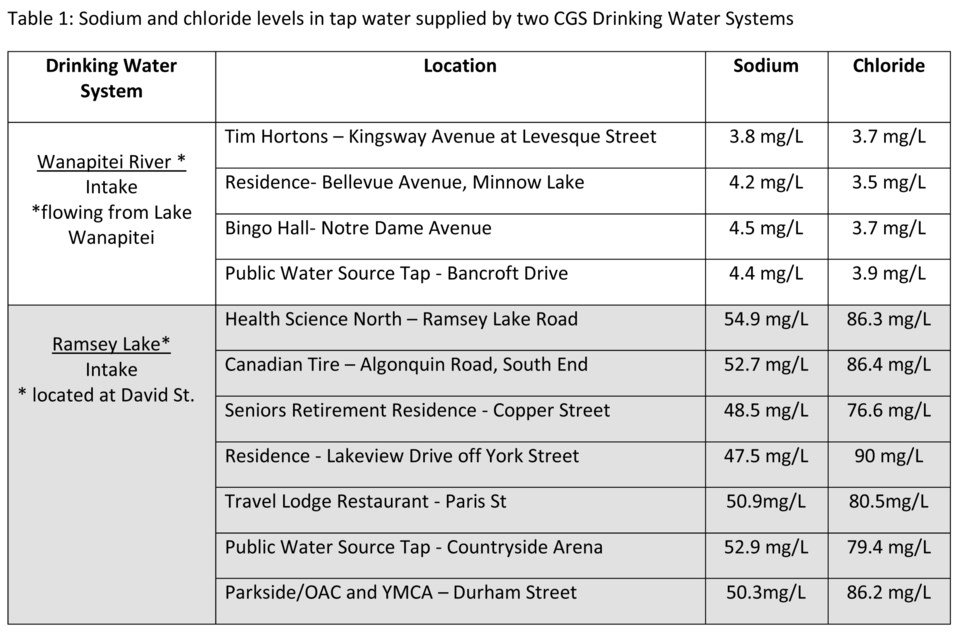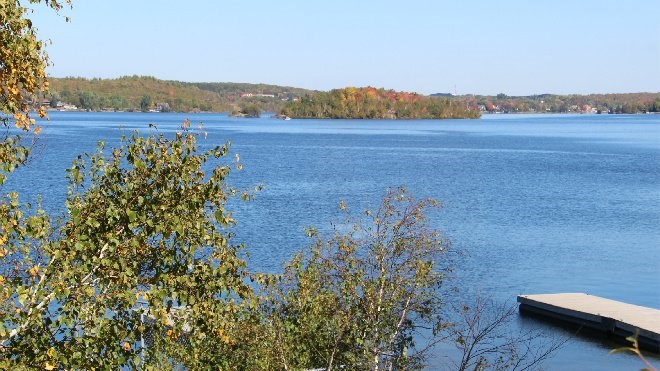Ramsey Lake, the drinking water source for some 40,000 Sudburians, is salty, upwards of 30 times higher than the city’s other primary drinking water source, Lake Wanapitei.
These are the results of a study released Feb. 19 by the Greater Sudbury Watershed Alliance. In September and October 2019, volunteers with the Minnow Lake Restoration group collected water samples from a dozen public and private locations fed by drinking water from Ramsey Lake (eight locations) and Wanapitei River (four locations).
The samples were analyzed by Testmark Laboratories, the alliance said in a news release.
You can see the results of those tests in the table below.
 Water sampling results showing sodium and chlorine levels in two Greater Sudbury drinking water sources: Ramsey Lake and Lake Wanapitei. (Image: Greater Sudbury Watershed Alliance)
Water sampling results showing sodium and chlorine levels in two Greater Sudbury drinking water sources: Ramsey Lake and Lake Wanapitei. (Image: Greater Sudbury Watershed Alliance)As is evidence in the results, depending on where you live in the Nickel City, the amount of sodium and chloride you’re consuming can vary widely.
“When water systems contain sodium concentrations higher than 20 mg/L, the Medical Officer of Health must be advised, who in turn notifies community physicians,” the alliance stated. “For persons with chronic diseases requiring a sodium-restricted diet, the intake of sodium from drinking water could be significant.”
Surface water sampling g on Ramsey, Lake Nepahwin and Minnow Lake also showed high levels of sodium and chloride. See the table below.
 Surface water sampling results from three urban lakes in Greater Sudbury taken in 2019. (Image: Greater Sudbury Watershed Alliance)
Surface water sampling results from three urban lakes in Greater Sudbury taken in 2019. (Image: Greater Sudbury Watershed Alliance) The GSWA said the levels are high enough that aquatic ecosystems in all three lakes could be at risk.
“The Canadian Water Quality Guideline for chloride levels to protect aquatic life is 120 mg/L. Especially important are zooplankton, a significant group of microscopic organisms that ‘graze’ on algae (including blue green algae),” the release stated. “Recent evidence suggests that chloride may be more toxic to zooplankton in lakes on the Cambrian Shield. Therefore, a resilient aquatic ecosystem in all three sampled lakes may be threatened.”
As chloride levels rise, zooplankton populations shrink. Lake temperature rise as a result of climate change coupled with a loss of zooplankton could lead to increasing algal blooms, the alliance said. Should these impacts not be mitigated, the Ramsey Lake drinking water system itself would be threatened, and so would recreational opportunities and property values.
Ramsey Lake supplies about 40 per cent of the drinking water for the urban parts of the city: South End, West End and downtown. The Wanapitei River supplies Coniston, Wahnapitae, New Sudbury and parts of downtown Sudbury and Garson.
Once sodium and chloride enter the water system they “cannot economically be removed by any treatment method,” GSWA reported. As well, chloride levels in watershed are used as an indicator of increasing urbanization, since a major source of the chemical is run-off from roadways and parking lots.
“Currently there is no viable substitute for the salt required to keep local roadways bare as required by provincial legislation,” GSWA reported.
The alliance said the city has worked to minimize the impact of de-icing salt on roads, sidewalks and parking lots, and have made changes to snow removal procedures within the Ramsey Lake Watershed to minimize salt leaching into the waterbody.
However, use of salt on commercial or private parking lots and driveways is unregulated, the alliance said, and outreach to private contractors to encourage best practices when it comes to salt use (the alliance hosted two Smart About Salt training sessions) were poorly attended, GSWA said.
“It is not unusual to see large chunks of road salt remaining on parking lots in Sudbury after the snow is removed,” the alliance said.
The GSWA said it has written letters to various government agencies expressing its concerns in to salt use as a de-icing agent and suggesting that development in the watershed that would involve new and widened roadways and large parking lots be carefully considered.
“We continue to consult with environmental experts and examine recent research findings that warn of the harmful effects of increased levels of salt (sodium and chloride) in our water environment.”
